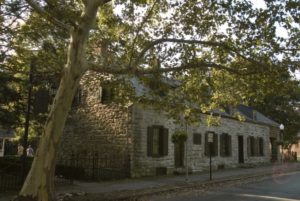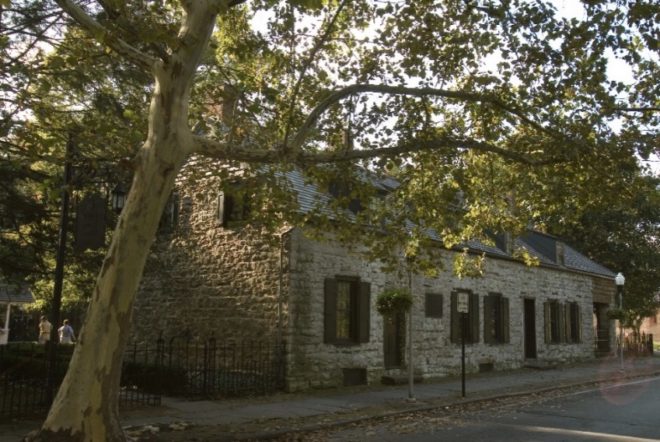
By Aaron Robinson, Historic Site Manager, Senate House State Historic Site
September is here, marking the last days of summer and the beginning of fall. It was around this time, 244 years ago, in 1777, that Kingston would play a key role in the bloody and complicated ordeal of declaring and realizing their independence from Great Britain.
In 1776, when the Continental Congress officially declared independence, it recommended that each state create its own constitution. The acting government of New York at the time, the New York Provincial Congress, set about this work with a committee of 13 men designated to draft the document. The leading authors would be familiar names of powerful men in New York you may have heard of; John Jay, Robert R. Livingston, and Gouvernor Morris (not the actual Governor, Gouvernor was his name).
During the drafting of this important document, the government had agreed to shift itself to Kingston after scouting out the area and determining it had sufficient space at a good enough price to house them. During their time in Kingston, after much wrangling, the Constitution was ratified in April of 1777, making Kingston New York’s first capital.
The form of the government might sound familiar to us now, but for the time it had several new innovations brought about by revolutionary ideas, while maintaining some of the previous pillars familiar from the British system. The government consisted of a State Assembly and a State Senate, a Judiciary branch headed by a Chancellor, and a popularly elected, but powerful Governor. This new constitution would expand the electorate, enshrine the notion of popular sovereignty (power of government deriving from the people), but take pains to limit more direct democracy, or what some at the time referred to as “mob rule”.
Voting was still limited to men that met a specific property threshold. That threshold increased when voting for senators and for Governor. The franchise was not extended to women, the enslaved, or those who did not have the appropriate wealth, ensuring a relatively small sample size at the polls. The document also did not touch the institution of slavery, under which most Black New Yorkers suffered.
Once the New York State Constitution was ratified, representatives elected, and offices filled, they needed a place to meet. The New York State Senate chose to rent a room in the home of a relatively prominent Kingstonian, Abraham VanGaasbeek. Abraham had served as a town supervisor, helped to establish the local Kingston Academy, and captained a sloop that ran to and from New York City to supply a store he managed. VanGaasbeek, had signed on to the revolutionary cause from the beginning, solidified by his decision to house the new Senate. His son Peter too was a part of the revolutionary cause and was currently away serving as a militia captain. Abraham’s wife Sarah had recently passed away due to illness, so by the time the Senate came to Kingston in 1777 he likely occupied his home with one or more individuals he enslaved through the course of his life.
The senators began that September by working through some of the business of government, including making decisions about the balance of power, the war effort, and their response to the new Governor’s recent address. Their visit to Kingston and the VanGaasbeek home was short-lived. Word soon came of the British advance up the Hudson River and the fall of Forts Clinton and Montgomery further south. Still a government on the run, the British advance meant that the senators and the rest of the representatives had to flee. They would depart in early October of 1777, just over a week before the British would land at Kingston and put the entire city to the torch. While most of the residents had evacuated, the damage was significant. The British retreated back down the Hudson, having learned of their major defeat at Saratoga, north of Albany, which left their plans for New York in tatters. The Continental Army and the citizens of Kingston would rebuild starting the following year. Fortunately, a good number of the structures that were damaged in the burning survived, including Abraham VanGaasbeek’s home, known today as Senate House.
So as September turns to October, take some time to reflect on the role Kingston played in the cause of American Independence, and the effect some of the major decisions made during that time are still with us today.
By Aaron Robinson, Historic Site Manager, Senate House State Historic Site
Published in the Kingston Wire, September 13, 2021
